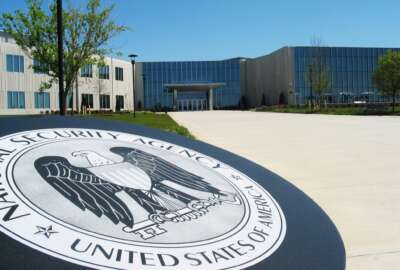NSA plans new ‘innovation pipeline’ to focus on China
The new concept, "Red Ventures," will help the NSA coordinate both internal ideas and work with outside partners on technology innovation.
The National Security Agency’s China directorate will soon launch an “innovation pipeline” focused on the competition with China and solving the NSA’s most pressing challenges.
David Frederick, the NSA’s assistant deputy director for China, said the new program will be called “Red Ventures.” During a webinar hosted by the Intelligence and National Security Alliance on Tuesday, Frederick said the effort should be launched within the next six months.
“You’ll be hearing about some opportunities to come and talk about potential solutions related to our challenge problems to feed a new innovation pipeline that we’re going to establish,” Frederick said. “That’s meant to reach out to industry and also internally to our workforce to look for a whole range of solutions to our hardest problems.”
The focus will be on China and “the China mission,” an NSA spokesman told Federal News Network. Frederick said the NSA would be working with “the defense industrial base and technology partners” on innovation.
“We are working within my new organization to better align multiple innovation activities within NSA and with our IC partners to focus on the China problem,” Frederick said during the INSA event.
The NSA has increasingly focused its activities around countering China, which NSA Director Paul Nakasone has called a “global challenge.” In 2022 congressional testimony, Nakasone announced a “China Outcomes Group” under Cyber Command and NSA leadership to “ensure proper focus, resourcing, planning and operations to meet this challenge.”
The NSA’s China directorate was subsequently established earlier this year under the leadership of Frederick, who was previously executive director of CYBERCOM. Frederick “sets and directs agency-wide mission strategy for addressing the People’s Republic of China, prioritizes mission investments, and postures NSA to achieve greater near- and long-term mission outcomes,” according to the NSA.
Frederick called “technology security” a “critical area of competition” between the United States and China.
“Some PRC officials have gone as far as to state that they view technology as the main battlefield between the United States and the PRC,” he said.
Frederick said the NSA’s role on technology security is informing policymakers about the efforts China is making to advance its technological objectives and gain control of key supply chains.
Meanwhile, regarding cybersecurity, Frederick said he’s primarily concerned about ensuring the United States continues to play a role in setting technology standards. And he’s also closely watching the progress of emerging technologies like generative artificial intelligence and quantum computing on cybersecurity efforts.
“I have incredible confidence in the US has ability to dominate and cure key technology fronts, but we have got to take this competition seriously,” Frederick said. “We are certainly the global innovation power today. And but we don’t want to lose that. We cannot be complacent or underestimate China’s capabilities.”
The NSA also recently completed an AI roadmap to help guide its internal use of the technologies.
As far as technology adoption processes, Frederick acknowledged it’s difficult for new companies to win Defense Department and intelligence community business due to arcane requirements and acquisition processes.
But he said he’s “optimistic” about DoD’s recent efforts in the innovation space, including the “increased emphasis” on the Defense Innovation Unit and Deputy Defense Secretary Kathleen Hicks’ recent announcement of the “Replicator” initiative.
“What I would like to see is more early engagement about overarching requirements,” Frederick said. “And when I say requirements, I don’t mean specifications, but broad challenge problems. I think that’s something that the DoD and the NSA could improve upon, is how do we communicate about our innovation gaps, our strategic gaps, in a way that helps small companies and medium sized companies think about ways to plug in and bring value.”
Copyright © 2025 Federal News Network. All rights reserved. This website is not intended for users located within the European Economic Area.
Follow @jdoubledayWFED






